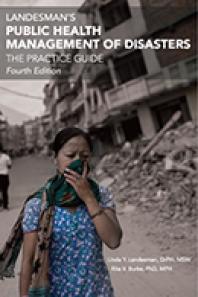 Guidelines for Foodborne Disease Outbreak Response
by
Guidelines for Foodborne Disease Outbreak Response
by
 Pathobiology of human disease : a dynamic encyclopedia of disease mechanisms
Pathobiology of human disease : a dynamic encyclopedia of disease mechanisms
 Landesman's Public Health Management of Disasters
The fourth edition of Landesman's Public Health Management of Disasters: The Practice Guide continues to serve as the only comprehensive work that provides a thorough foundation regarding Public Health's permanent role and responsibility in relation to the structure, organization and function of health management in emergency management and disaster prevention, preparedness, response, recovery and reconstruction.
Updates to the 4th edition takes into account the most current federal preparedness guidance from the National Preparedness Goal, the National Health Security Strategy, and the National Response Framework. Additional updates to emerging approaches for public health surveillance, laboratory and disaster information systems, as well as hospital surveillance in hospitals are included.
Landesman's Public Health Management of Disasters
The fourth edition of Landesman's Public Health Management of Disasters: The Practice Guide continues to serve as the only comprehensive work that provides a thorough foundation regarding Public Health's permanent role and responsibility in relation to the structure, organization and function of health management in emergency management and disaster prevention, preparedness, response, recovery and reconstruction.
Updates to the 4th edition takes into account the most current federal preparedness guidance from the National Preparedness Goal, the National Health Security Strategy, and the National Response Framework. Additional updates to emerging approaches for public health surveillance, laboratory and disaster information systems, as well as hospital surveillance in hospitals are included.
 Mims' Pathogenesis of Infectious Disease
Mims' Pathogenesis of Infectious Disease
 Nanotechnology in Diagnosis, Treatment and Prophylaxis of Infectious Diseases
Nanotechnology in Diagnosis, Treatment and Prophylaxis of Infectious Diseases
 Socio-Ecological Dimensions of Infectious Diseases in Southeast Asia
Socio-Ecological Dimensions of Infectious Diseases in Southeast Asia